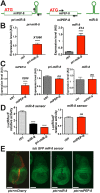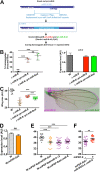Drosophila primary microRNA-8 encodes a microRNA-encoded peptide acting in parallel of miR-8
- PMID: 33892772
- PMCID: PMC8063413
- DOI: 10.1186/s13059-021-02345-8
Drosophila primary microRNA-8 encodes a microRNA-encoded peptide acting in parallel of miR-8
Abstract
Background: Recent genome-wide studies of many species reveal the existence of a myriad of RNAs differing in size, coding potential and function. Among these are the long non-coding RNAs, some of them producing functional small peptides via the translation of short ORFs. It now appears that any kind of RNA presumably has a potential to encode small peptides. Accordingly, our team recently discovered that plant primary transcripts of microRNAs (pri-miRs) produce small regulatory peptides (miPEPs) involved in auto-regulatory feedback loops enhancing their cognate microRNA expression which in turn controls plant development. Here we investigate whether this regulatory feedback loop is present in Drosophila melanogaster.
Results: We perform a survey of ribosome profiling data and reveal that many pri-miRNAs exhibit ribosome translation marks. Focusing on miR-8, we show that pri-miR-8 can produce a miPEP-8. Functional assays performed in Drosophila reveal that miPEP-8 affects development when overexpressed or knocked down. Combining genetic and molecular approaches as well as genome-wide transcriptomic analyses, we show that miR-8 expression is independent of miPEP-8 activity and that miPEP-8 acts in parallel to miR-8 to regulate the expression of hundreds of genes.
Conclusion: Taken together, these results reveal that several Drosophila pri-miRs exhibit translation potential. Contrasting with the mechanism described in plants, these data shed light on the function of yet undescribed primary-microRNA-encoded peptides in Drosophila and their regulatory potential on genome expression.
Keywords: Drosophila; Small peptides; lncRNA; miPEP; miR-8; sORF.
Conflict of interest statement
The authors declare that they have no competing interests.
Figures






Similar articles
-
Small ORFs as New Regulators of Pri-miRNAs and miRNAs Expression in Human and Drosophila.Int J Mol Sci. 2022 May 20;23(10):5764. doi: 10.3390/ijms23105764. Int J Mol Sci. 2022. PMID: 35628573 Free PMC article.
-
Functions of animal microRNA-encoded peptides: the race is on!EMBO Rep. 2022 May 4;23(5):e54789. doi: 10.15252/embr.202254789. Epub 2022 Mar 28. EMBO Rep. 2022. PMID: 35343609 Free PMC article.
-
Evidence That Regulation of Pri-miRNA/miRNA Expression Is Not a General Rule of miPEPs Function in Humans.Int J Mol Sci. 2021 Mar 26;22(7):3432. doi: 10.3390/ijms22073432. Int J Mol Sci. 2021. PMID: 33810468 Free PMC article.
-
The Essentials on microRNA-Encoded Peptides from Plants to Animals.Biomolecules. 2023 Jan 19;13(2):206. doi: 10.3390/biom13020206. Biomolecules. 2023. PMID: 36830576 Free PMC article. Review.
-
Regulatory miPEP Open Reading Frames Contained in the Primary Transcripts of microRNAs.Int J Mol Sci. 2023 Jan 20;24(3):2114. doi: 10.3390/ijms24032114. Int J Mol Sci. 2023. PMID: 36768436 Free PMC article. Review.
Cited by
-
From Yeast to Mammals, the Nonsense-Mediated mRNA Decay as a Master Regulator of Long Non-Coding RNAs Functional Trajectory.Noncoding RNA. 2021 Jul 27;7(3):44. doi: 10.3390/ncrna7030044. Noncoding RNA. 2021. PMID: 34449682 Free PMC article. Review.
-
The Role of microRNAs in the Drosophila Melanogaster Visual System.Front Cell Dev Biol. 2022 Apr 4;10:889677. doi: 10.3389/fcell.2022.889677. eCollection 2022. Front Cell Dev Biol. 2022. PMID: 35493095 Free PMC article. Review.
-
Small ORFs as New Regulators of Pri-miRNAs and miRNAs Expression in Human and Drosophila.Int J Mol Sci. 2022 May 20;23(10):5764. doi: 10.3390/ijms23105764. Int J Mol Sci. 2022. PMID: 35628573 Free PMC article.
-
Functions of animal microRNA-encoded peptides: the race is on!EMBO Rep. 2022 May 4;23(5):e54789. doi: 10.15252/embr.202254789. Epub 2022 Mar 28. EMBO Rep. 2022. PMID: 35343609 Free PMC article.
-
In Depth Exploration of the Alternative Proteome of Drosophila melanogaster.Front Cell Dev Biol. 2022 May 26;10:901351. doi: 10.3389/fcell.2022.901351. eCollection 2022. Front Cell Dev Biol. 2022. PMID: 35721519 Free PMC article.
References
-
- Bazzini AA, Johnstone TG, Christiano R, Mackowiak SD, Obermayer B, Fleming ES, Vejnar CE, Lee MT, Rajewsky N, Walther TC, Giraldez AJ. Identification of small ORFs in vertebrates using ribosome footprinting and evolutionary conservation. EMBO J. 2014;33:981–993. doi: 10.1002/embj.201488411. - DOI - PMC - PubMed
Publication types
MeSH terms
Substances
Grants and funding
LinkOut - more resources
Full Text Sources
Molecular Biology Databases
Research Materials

